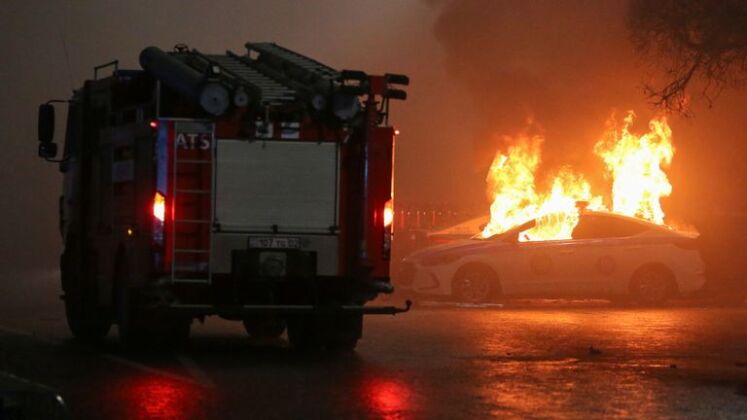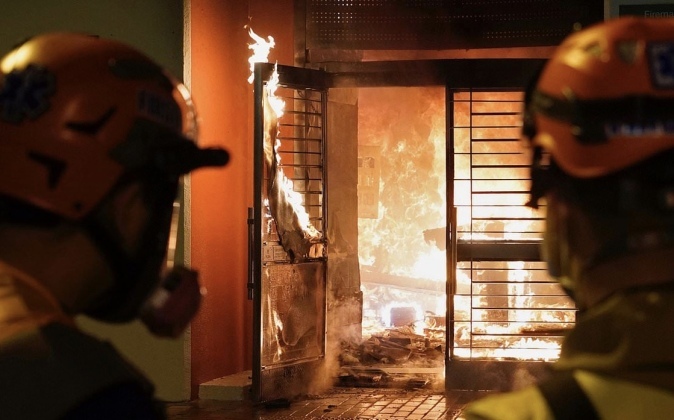On January 9th Kazakhstan’s acting Internal Affairs minister Yerlan Turgumbayev reported highly organised, skilled and disciplined actions by anti government rioters indicating a great deal of planning and organisation: “Across the board, protesters demonstrated their professional skills. Discipline and orderliness were notable in their actions. In the areas where they were situated and before attacks, street video surveillance cameras were disabled. Roadways were barricaded, observers were stationed along the perimeter. They used radios to coordinate their actions,” he said. Turgumbayev emphasised that rioters in Almaty initially outnumbered police and were more heavily armed, stating: “Large groups of protesters in different parts of the city attacked patrol squads. They took control of seven gun shops and seized weapons and ammunition. They seized public transport and municipal vehicles and used them to ram squads of law enforcement. They threw homemade incendiary mixtures and fired guns at police. They burned service vehicles, including fire engines.” He added that rioters and insurgents prevented ambulances from entering conflict zones. This followed a prior statement on January 5th that rioters “were better armed and organised [than law enforcement]. Due to their significant numerical advantage, they managed to break through several lines of defence and penetrate the building. Under the onslaught of the large crowd, police were forced to retreat to avoid accidental casualties.” 16 members of law enforcement have been killed so far and over 1,300 injured, with 346 police vehicles destroyed and over 100 stores and banks damaged. Total damages have come to around $215 million, as the Kazakh government reports counterinsurgency operations are nearing an end. Insurgents have been reported to use assault rifles against police from the conflict’s early stages, although use of petrol bombs has been particularly widespread.

Kazakh authorities have highlighted a strong presence of foreign elements among anti-government forces, with arrested foreign nationals admitting to having been paid to travel to Almaty and support such activities. Amid ongoing violence in Kazakhstan as major riots quickly escalated into a full blown insurgency, Russia’s Foreign Ministry has repeatedly indicated that foreign parties have played a major role in organising a campaign against the Kazakh government at times singling out the United States in particular. On January 10th Russian President Vladimir Putin notably compared the insurgency in Kazakhstan to the methods used to overthrow the Ukrainian government in 2014 and strongly implied Western involvement, stressing that the Central Security Treaty Organisation which includes Kazakhstan “would not allow colour revolutions” on its territory. ‘Colour revolution’ being a term frequently used in Russia for hybrid warfare involving support for rioters and insurgents in enemy states. Belarusian President Alexander Lukashenko, whose country after Russia was the second to send material support to Kazakhstan, that day emphasised that the CSTO needed to be strengthened in the face of future potential threats in light of the destruction in Kazakhstan. Kazakh President Kassym-Jomart Tokayev himself pointed to foreign involvement in the insurgency, stating on January 10th that Nur Sultan would soon provide evidence to the international community of this.

Supporting claims made by Kazakh and Russian officials, Dzmitry Halko from the U.S. state media outlet Radio Free Europe who was present in Kazakhstan and supported anti-government forces reported that for the movement against the government it was valuable to have “studied the experience of protests in Hong Kong and other countries,” where U.S. and Western involvement has been more clearly proven. This follows increasingly widespread assessments pointing to strong similarities between the riots in Hong Kong in 2019 and Almaty in 2022 including the tactics used against the government such as the widespread burning of government buildings and public infrastructure. Halko further highlighted that the U.S. government’s National Endowment for Democracy, which has for decades supported often violent opposition groups in countries outside the Western sphere of influence in collaboration with U.S. intelligence, delivered $1 million to anti-government groups in Kazakhstan in the past year alone. A number of analysts have thus highlighted the possibility of ‘hybrid warfare’ being organised in Kazakhstan using a Hong Kong model. Others have pointed to consistencies, albeit lesser ones, with Western-backed riots in Sudan, Algeria and Thailand in 2019, Belarus in 2020, and even Syria in 2011, claiming that the Kazakh insurgency represents the latest evolution in Western ‘hybrid warfare’ targeting governments for overthrow. These kinds of organised riots have succeeded in topping governments in the past, most notably Sudan in 2019 and Ukraine in 2014, and have in other cases led to civil war such as Syria.
